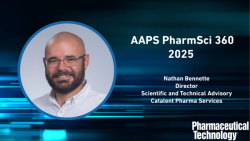
OR WAIT null SECS
- About Us
- Advertise
- Contact Us
- Editorial Info
- Editorial Advisory Board
- Do Not Sell My Personal Information
- Privacy Policy
- Terms and Conditions
© 2025 MJH Life Sciences™ , Pharmaceutical Technology - Pharma News and Development Insights. All rights reserved.
Characterization of nanomedicines
Nanomedicines can offer promising benefits in the diagnosis and treatment of diseases but there are still concerns about the safety and quality of these therapeutics partly because of the lack of clear regulatory guidance. Scott McNeil, PhD, director of the Nanotechnology Characterization Laboratory (NCL), spoke with Pharmaceutical Technology about nanomedicine characterization.
While it is recognized that nanomedicines can offer promising benefits in the diagnosis and treatment of diseases, there are still concerns about the safety and quality of these therapeutics partly because of the lack of clear regulatory guidance. Scott McNeil, PhD, director of the Nanotechnology Characterization Laboratory (NCL), a collaboration among the National Cancer Institute (NCI), the National Institute of Standards and Technology (NIST), and FDA, spoke with Pharmaceutical Technology about nanomedicine characterization.
FDA does not currently have specific guidance or require specific additional characterization for nanomedicines or products containing nanoscale materials beyond what is required for traditional products, McNeil notes. However, recommendations have been made to FDA to develop nanomedicine-specific guidances for industry, and FDA scientists have acknowledged areas of special focus for nanomedicines in public presentations.
PharmTech: What characterization studies are required for nanomedicines?
McNeil: At NCL, we evaluate nanomedicines in an assay cascade that has been developed specifically to tailor tests routinely used in the pharmaceutical industry to the unique properties of nanomaterials. As part of its assay cascade, NCL characterizes nanomedicines’ physical attributes, their in-vitro biological properties, and their in-vivo compatibility using animal models. NCL also looks at trends across nanoparticle platforms, parameters that are crucial to nanoparticle biocompatibility, and develops new assays to identify and address areas of potential safety risks. NCL has developed more than 40 protocols that rigorously characterize nanoparticle physicochemical properties, as well as in-vitro immunological and cytotoxic characteristics and administration, distribution, metabolism, and elimination (ADME)/toxicity profiles in animal models. These assays have undergone extensive in-house validation and are subjected to regular revision to ensure applicability to a variety of nanomaterials.
PharmTech: What are the challenges associated with the characterization of nanomedicines?
McNeil: Most of the challenges associated with testing nanomedicines arise from their complexity. Nanomedicines are complicated formulations that incorporate not only drugs, but also polymeric coatings, targeting ligands (such as antibodies), and imaging agents among others. Expertise is required to successfully develop these products, and bring them to clinic and onto the market. Not only must the developer understand the chemistry to synthesize the nanomedicine reproducibly, but they must also have the requisite knowledge to thoroughly test and understand its biodistribution, metabolism, pharmacokinetics, toxicological profile, and immunological consequences.
Some of the most common pitfalls encountered by the NCL are listed below. These challenges and others are described in detail in, ‘Common pitfalls in nanotechnology: lessons learned from NCI’s nanotechnology characterization laboratory’ by Crist et al. (1).
- Sterility and endotoxin contamination should be addressed before you test your nanomedicine in animals. Endotoxin is a component of the cell wall of some bacteria, and tends to stick to nanoparticles, especially those that are positively charged. Contamination can cause misleading results in animal testing. Further complicating the issue, many nanomaterials interfere with traditional tests routinely used in the pharmaceutical industry to measure endotoxin. Therefore, it is important to include all appropriate controls when looking for endotoxin concentration in nanomedicines.
- Always thoroughly characterize a nanomaterial, and do so under biologically relevant conditions such as physiological temperature and pH.
- Consider the biological consequence of every component that is used in the manufacturing and purification process. If a non-biologically compatible component is required, develop a test to detect and quantify it in your nanomedicine.
- Test the biocompatibility of every component, including linkers and components of the formulation. If nontoxic or more biocompatible components are available, use them.
- Test batch-to-batch consistency at an early stage in the product development process. Poor batch-to-batch consistency may cause results on multiple batches of material to vary unpredictably.
- Find an appropriate test to assess nanoparticle stability and drug release under physiologically relevant conditions.
PharmTech: What is the best way to accelerate the development of nanomedicines?
McNeil: Nanomedicines may be at a critical juncture as a handful of option deals between large pharmaceutical companies and small biotech companies developing nanomedicines seem to indicate interest and investment in this technology. Across the pharmaceutical industry, larger firms have focused on late-stage clinical validation and distribution, with less in-house early R&D. Instead of doing the early, risky studies themselves, large pharmaceutical companies have been acquiring small biotech companies with products already in clinical trials. Continued investment in nanotech from pharma will be crucial to the advancement of nanomedicines.
A globally unified approach to nanomedicine characterization and greater certainty in the regulatory pathway would greatly assist nanomedicine developers in advancing their technologies. Countries should work together to establish coordinated approaches to testing/characterization and regulation. Specifically, the EU and US, which are home to most of the big pharmaceutical companies, should make efforts to coordinate and harmonize their regulatory framework for nanomedicines.
Scale up and development of GMP for nanomaterials are critical vulnerabilities for many nanotech start ups. Such companies struggle to find contract manufacturing and research organizations with experience in the manufacture and testing of nanomaterials. They also face challenges in reproducible scale up to produce sufficient amounts of nanomedicine for large clinical trials. As previously mentioned, nanomedicines are often complicated formulations that may incorporate many components (e.g., the drug,
polymeric coatings, targeting ligands such as antibodies, and imaging agents); supply chain issues in manufacturing, scale up, and testing can, therefore, overwhelm a small start up. Funding agencies should develop a coordinated strategy to provide assistance in this area.
Reference
1. Crist et al., Integrative Biology 5(1) 66-73 (2013).
Related Content:



